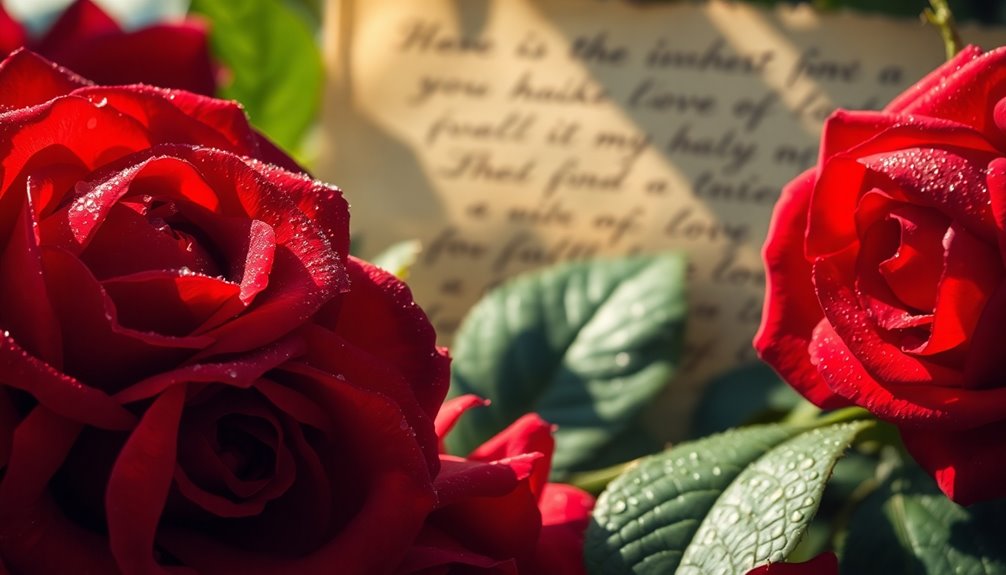Roses symbolize love, beauty, and passion in many cultures, tracing their roots back to Greek mythology, where they were sacred to Aphrodite. Roman traditions also celebrated their connection to Venus, associating roses with emotional intensity. In Christianity, the Virgin Mary is represented by the "rose without thorns," while in Eastern cultures, roses embody spiritual devotion. Today, roses remain a potent symbol of romance and carry layers of meaning that intertwine deeply with history and tradition. You might discover even more fascinating insights as you explore further.
Key Takeaways
- Roses symbolize love and beauty, rooted in mythology with connections to Aphrodite and Venus, goddesses of love in Greek and Roman cultures.
- Different colored roses convey distinct meanings, with red roses representing deep passion and white roses symbolizing purity and innocence.
- In Christianity, roses are linked to the Virgin Mary, representing sacred love and purity, with the term "rosary" deriving from their symbolism.
- The science behind roses, including their pigments and fragrances, enhances their romantic significance and psychological associations with love and passion.
- Roses maintain their status as a timeless symbol of love, celebrated in art and literature, reflecting enduring emotions across cultures and eras.
Aphrodite & Greek Mythology

In the domain of Greek mythology, few figures embody love and beauty like Aphrodite. Born from sea foam or considered the daughter of Zeus and Dione, she's a powerful symbol of romantic desire.
Her influence extends beyond mere tales; she's woven into the very fabric of love itself. Roses, in particular, hold a special connection to her, representing not only beauty but also the complexities of love.
As her worship flourished, rituals like the Aphrodisia festival celebrated her divine essence, where offerings often included roses. These blooms became synonymous with Aphrodite, encapsulating her spirit and the deep emotions tied to love.
Through her, roses transformed into timeless symbols of affection, forever linked to the goddess who reigns over matters of the heart.
Roman Mythology
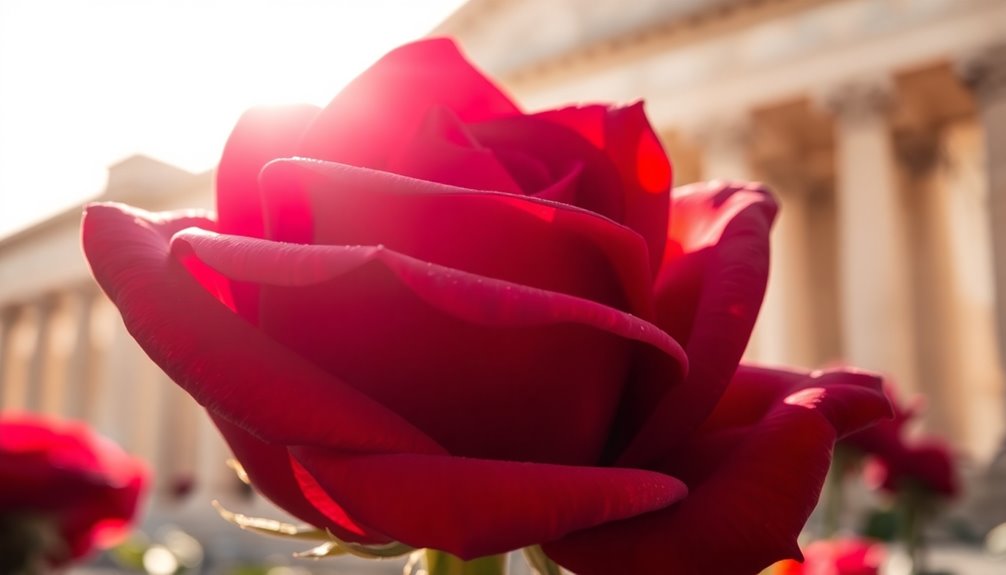
Roses maintained their significance as symbols of love when they crossed into Roman mythology, where they were dedicated to Venus, the goddess of love. These red roses symbolized beauty and desire, often featured in worship rituals. Romans believed roses had divine properties, decorating banquet tables and wealthy homes to enhance romantic ambiance.
| Aspect | Description |
|---|---|
| Symbolism | Roses symbolize love and emotional intensity |
| Cultural Practices | Used in rituals and as gifts during life events |
| Luxury | Emperors bathed in rose petals for indulgence |
| Secrecy | "Sub rosa" indicated confidentiality |
In Roman culture, the red rose became a token of profound feelings, showcasing its lasting legacy in love's symbolism.
Virgin Roses: The Influences of Christianity
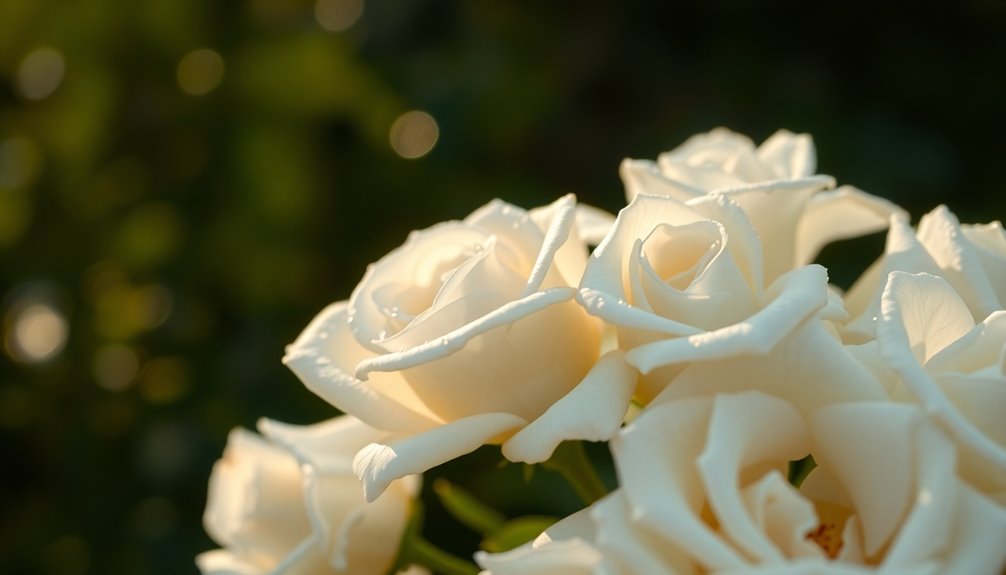
In Christianity, roses symbolize purity and are closely tied to the Virgin Mary, often depicted as the "rose without thorns."
You may notice how artistic representations highlight her innocence and maternal qualities, reinforcing the belief in her divine love.
Additionally, the idea of thornless roses in the Garden of Eden emphasizes the concept of untainted beauty in Christian theology.
Symbol of Purity
The rose, often revered for its beauty, serves as a powerful symbol of purity and innocence within Christianity. Closely linked to the Virgin Mary, she's affectionately called the "rose without thorns," representing sacred love and divine purity. This connection has deep historical roots, as even the Garden of Eden is believed to have had thornless roses before Original Sin.
| Symbol | Meaning |
|---|---|
| Virgin Mary | Embodiment of purity |
| Rose | Divine love and beauty |
| Rosary | Faith and devotion |
This iconography, especially during the Gothic period, emphasizes the rose's significance in conveying faith, innocence, and the maternal qualities of the Virgin Mary.
Virgin Mary Depictions
Connected deeply to the Virgin Mary, depictions of her often feature roses, emphasizing her purity and divine grace.
In Christianity, the rose symbolizes innocence and sacred love, with references to this connection dating back to the third century. You might notice that in Gothic art, artists frequently portray the Virgin Mary surrounded by roses, reinforcing her role as the epitome of purity.
The term "rosary" itself derives from roses, representing a garland used in prayer and devotion to her. The miracle of the roses also highlights this association, as evidenced in the life of Saint Elizabeth of Hungary, where roses blossomed from her hands during acts of charity.
Through these images, roses embody the essence of the Virgin Mary's love and grace.
Thornless Roses Belief
Believing in thornless roses, often referred to as "virgin roses," stems from the idea that these flowers flourished in the Garden of Eden before Original Sin tainted creation.
These roses symbolize purity and innocence, closely linked to the Virgin Mary, who's often depicted with them in Gothic art.
By the third century, the red rose emerged as a powerful symbol of the Virgin Mary, representing her maternal love and divine grace.
The term "rosary" itself derives from the notion of a bouquet of roses, embodying a collection of prayers and devotion to Mary.
Miracle stories involving roses, like those of Saint Elizabeth of Hungary, further cement their sacred associations, enhancing their symbolism within Christianity.
Roses in the Eastern World

In the Eastern world, roses hold deep cultural significance, tracing back to ancient Chinese rose gardens cultivated around 5,000 years ago.
You'll find that the Hindu goddess Lakshmi, embodying beauty and love, is said to have originated from rose petals, illustrating the flower's spiritual connections.
These examples highlight how roses have shaped traditions and beliefs across Eastern cultures.
Ancient Chinese Rose Gardens
While roses have long been celebrated in various cultures, their significance in ancient China truly stands out. Cultivated around 5,000 years ago, roses symbolize beauty and love, becoming integral to cultural traditions.
Here are some highlights of ancient Chinese rose gardens:
- Cultural Roots: Roses were linked to the goddess of love and beauty, representing romantic love.
- Dynastic Flourishing: The Tang Dynasty (618-907 AD) saw roses embraced in poetry and art.
- Health Benefits: During the Song Dynasty (960-1279 AD), roses were valued for their medicinal properties.
- Artistic Expression: Intricate rose motifs in traditional art demonstrate their enduring significance.
These elements showcase how rose gardens enriched the fabric of ancient China, embodying deep meanings of devotion and romance.
Hindu Goddess Lakshmi's Connection
Roses hold a prominent place in Hindu culture, particularly through their association with the goddess Lakshmi. Often depicted emerging from rose petals, Lakshmi embodies love and beauty, symbolizing the divine qualities of prosperity and abundance.
During festivals, you'll see rose petals used in rituals and decorations to invoke her blessings, reinforcing the themes of devotion and purity. This connection emphasizes how roses represent not just floral beauty, but also spiritual richness in Hindu traditions.
Ancient texts highlight the significance of the rose in representing the divine feminine, linking it closely to Lakshmi. The cultivation of rose gardens in India further reflects this historical reverence, making roses essential in celebrating devotion to the goddess Lakshmi and the qualities she represents.
Roses in Modern Society

The enduring symbolism of roses, especially red ones, remains a powerful part of modern society. They're often the go-to gift for expressing romantic love, whether on Valentine's Day or anniversaries.
Here's how roses continue to thrive in contemporary culture:
- Romantic Selection: Reality shows like The Bachelor use red roses to symbolize commitment.
- Political Emblem: Red roses represent socialist and social democratic movements, championing social justice.
- Cultural Celebrations: Events like the Rose Festival and the Tournament of Roses Parade highlight their significance.
- Victorian Legacy: The language of flowers still resonates, with a single red rose conveying "I love you" in modern times.
Roses remain a timeless symbol of love and passion, bridging past and present.
The Language of Roses
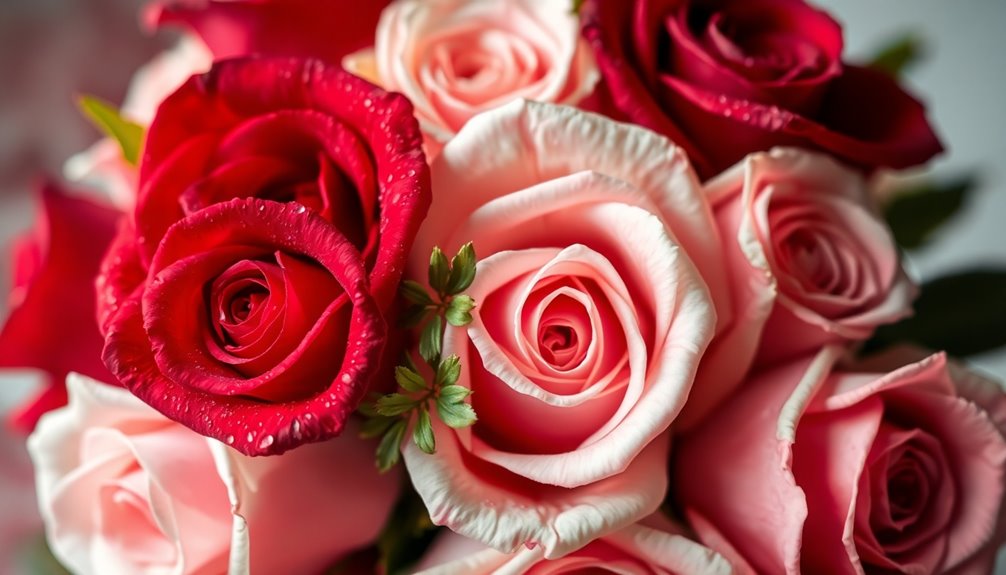
Throughout history, flowers have served as a unique means of communication, and the language of roses stands out for its rich symbolism and emotional depth. In the Victorian era, the rose is used to convey feelings that words often couldn't express. The red rose became synonymous with love, representing deep devotion and passion. A single red rose is perfect for romantic declarations, while a bouquet can signify admiration and lasting affection.
Different colored roses carry distinct meanings; for instance, white roses symbolize purity and innocence. The language of roses extends beyond romance, with specific arrangements conveying complex emotions and intentions. This tradition persists today, especially in romantic gestures during occasions like Valentine's Day and anniversaries.
Symbolism in Art and Literature

In art and literature, roses often take on profound meanings that reflect human emotions and experiences. The rose as a symbol has been explored in various ways, from ancient Greek mythology to modern narratives.
Here are four notable examples:
- Shakespeare's "Romeo and Juliet": The red rose symbolizes the depth and tragedy of enduring love.
- "Romance of the Rose": This medieval poem personifies the rose as a woman, highlighting desire's complexities.
- Faulkner's "A Rose for Emily": The rose represents love, secrecy, and the passage of time.
- Eco's "The Name of the Rose": Here, the rose intertwines themes of knowledge, beauty, and human experience.
Through these works, the red rose was created as a timeless emblem of passion and beauty, often reflecting the symbolism of nature found in poetry and other literary forms.
The Science of Red Roses

Roses captivate not just with their beauty, but also with the science behind their vibrant red hue. The deep red pigment of the red rose comes from anthocyanins, water-soluble pigments that create its rich color.
This striking hue evokes strong psychological associations with love and passion, making it a symbol of true love. In the ancient world, the red rose was often linked to the Goddess of Love, enhancing its romantic significance.
The rose's enchanting fragrance, derived from volatile organic compounds, further deepens its allure, making it a favorite for expressing affection. Research shows that this aroma can lift your mood and reduce stress, solidifying the red rose's place as a timeless emblem of love and attraction.
Timeless Beauty
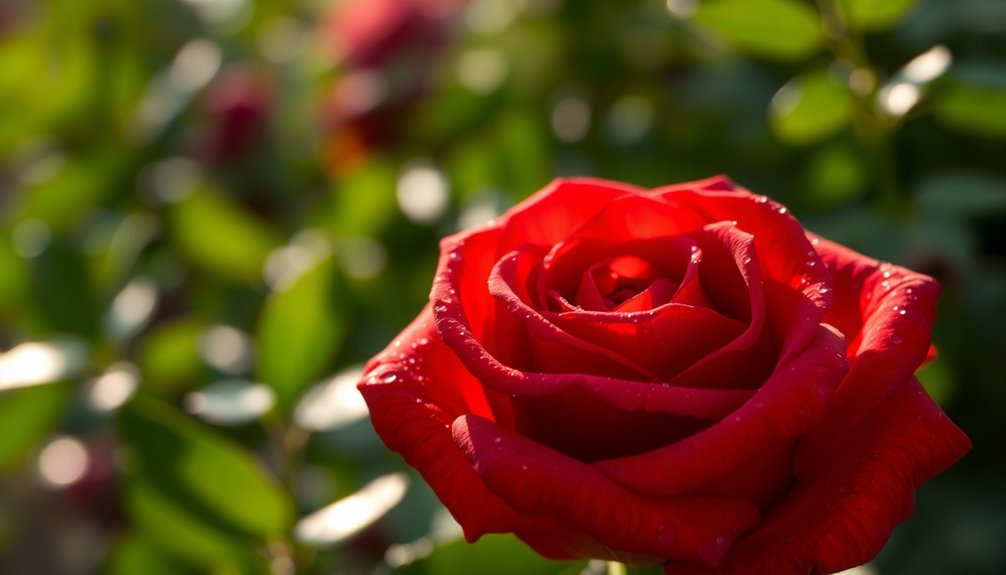
Beauty transcends time, and the red rose embodies this truth like no other flower. As a symbol of love, its significance spans cultures and eras, from ancient Greece to Victorian society. The red rose has captivated hearts, serving as a timeless emblem of passion and affection.
Here are four reasons why its beauty endures:
- Mythological Roots: Linked to Aphrodite, the goddess of love, the red rose has a rich history.
- Victorian Floriography: In this era, a single red rose conveyed deep affection, saying "I love you."
- Emotional Impact: Its vibrant color and fragrance evoke strong feelings, enhancing its allure.
- Artistic Legacy: Renowned artists and writers have celebrated the red rose, capturing its complexities in their works.
Modern Interpretations
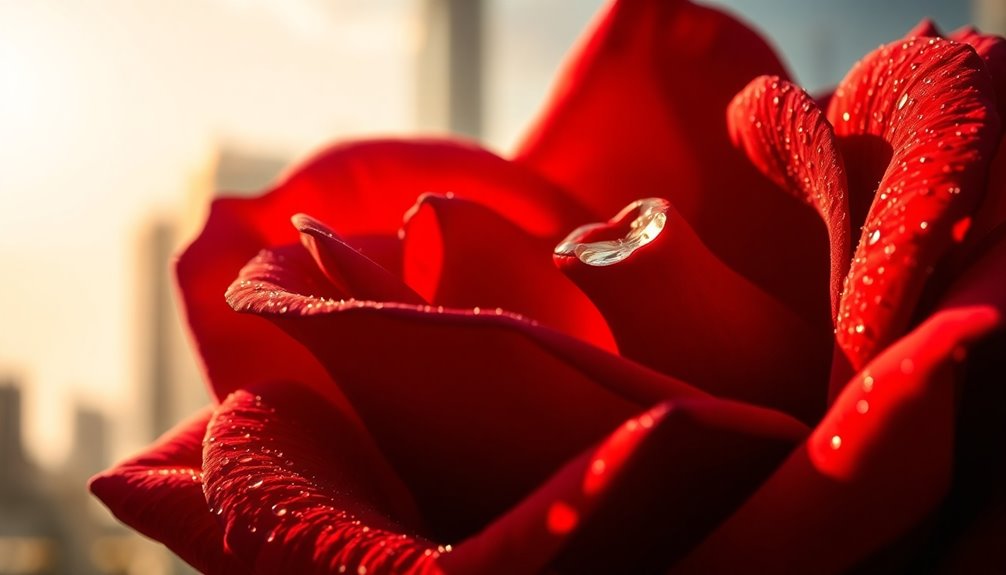
The enduring allure of red roses has evolved, embracing modern interpretations that reflect the complexities of contemporary relationships.
Today, red roses are more than a symbol of love; they represent various emotional connections, including romantic, familial, and even self-love. A single red rose can convey deep affection, while a bouquet may signify extravagant passion. Yet, the thorns remind you that love's duality of pleasure and pain is ever-present.
Commonly associated with special occasions like anniversaries and Valentine's Day, red roses remain timeless in their romantic appeal. They also express respect and gratitude during significant life events, reinforcing their status as a multifaceted symbol of love in today's world. Additionally, the importance of emotional support in relationships is reflected in the way roses can symbolize care and compassion during difficult times.
Frequently Asked Questions
Why Did Roses Become a Symbol of Love?
Roses became a symbol of love due to their beauty, fragrance, and rich colors, which evoke strong emotions.
When you see a red rose, it stirs feelings of passion and affection, making it the perfect expression of love.
This association deepens through cultural traditions and literature, where roses frequently appear in romantic contexts.
Over time, their significance has solidified, leading you to associate roses with heartfelt sentiments and special occasions in your life.
What Is the History of the Rose Symbolism?
Roses have a rich history tied to various cultures and mythologies. You'll find their association with love dating back to the ancient Greeks and Romans, where they were linked to the goddess Aphrodite.
As time passed, during the Victorian era, the language of flowers emerged, giving roses a deeper emotional significance. Their vibrant color has often represented passion, making them a timeless symbol of affection in art, literature, and religious contexts throughout the ages.
What Does 🌹 Symbolize?
When you see a red rose, it symbolizes deep romantic love and passion. It evokes strong emotions, making it a go-to choice for expressing affection.
Whether you're giving one or receiving it, a single red rose says "I love you," while a bouquet communicates deeper devotion.
Beyond romance, it can also represent familial love and self-love, making it a versatile symbol of heartfelt connections in various celebrations and significant moments.
Why Are Red Roses a Symbol of Love Greek Mythology?
Red roses symbolize love in Greek mythology because they're tied to the story of Aphrodite and Adonis.
When Adonis died, Aphrodite's tears mixed with his blood, transforming white roses into red ones.
This narrative illustrates deep love and sacrifice, making red roses a powerful emblem of romance.
Whenever you see a red rose, remember its rich connection to passion and devotion, rooted in these ancient myths that still resonate today.
Conclusion
In every petal of a rose, you can feel the whispers of ancient gods and the echoes of love stories that could make even the toughest heart melt. From Greek myths to modern romance, roses have bloomed through time, proving they're the ultimate symbol of love. So, whether you're gifting a single stem or a dozen, remember: you're not just giving flowers; you're handing over a piece of history and a splash of magic that could spark a thousand love tales!
